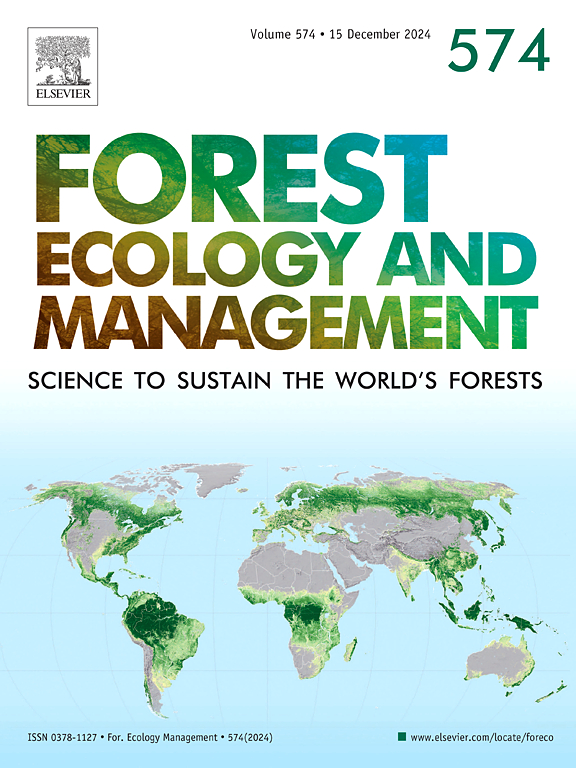Parallel but different deaths: sudden drought-trigged mortality in Scots pine versus slow climate- and mistletoe-driven mortality in silver fir
IF 3.7
2区 农林科学
Q1 FORESTRY
引用次数: 0
Abstract
In recent decades, forest die-off events have increased worldwide due to warmer droughts, with Southwestern Europe emerging as a mortality hotspot. This region is notably affected by widespread decline and die-off episodes, particularly in mountain forests dominated by Abies alba (silver fir) and Pinus sylvestris (Scots pine). We study four stands (two Scots pine, two silver fir) showing ongoing die-off in the Spanish Pyrenees, near the southwestern edge of both species’ distributions. Our objectives were to analyze growth patterns of declining trees in mortality hotspots, and to study the climatic (drought) and biotic (mistletoe) factors contributing to this decline. Using dendroecological methods and a recently developed change-point analysis approach, we assessed differences in growth patterns at stand and individual tree levels. Results showed that mortality events were recent, especially for Scots pine. Although mortality patterns were tree-specific, Scots pine typically exhibited a sudden growth decline before death or a sudden mortality without prior growth decline, whereas silver fir generally showed gradual and prolonged growth decline preceding mortality. Drought and elevated temperatures were the primary triggers for Scots pine and the warmer-drier silver fir site, with secondary contributors such as historical management and microsite conditions (soil, aspect, slope, moisture, density, size, age, competition). Conversely, in the colder-wetter silver fir site, mistletoe was the sole driver of decline and mortality. These findings highlight the complex interplay of primary and secondary stressors underlying forest die-off.
平行但不同的死亡:突然干旱引发的苏格兰松死亡率与缓慢的气候和槲寄生导致的银杉死亡率
近几十年来,由于全球变暖的干旱,森林死亡事件在全球范围内有所增加,欧洲西南部成为死亡热点。该地区明显受到大范围衰退和死亡事件的影响,特别是在以冷杉(silver fir)和苏格兰松(Pinus sylvestris)为主的山林。我们研究了西班牙比利牛斯山脉的四个林分(两个苏格兰松,两个银杉),它们在这两个物种分布的西南边缘附近正在死亡。我们的目标是分析死亡热点地区树木的生长模式,并研究导致这种下降的气候(干旱)和生物(槲寄生)因素。利用树木生态学方法和最近发展的变化点分析方法,我们评估了林分和单株水平上生长模式的差异。结果表明,死亡事件是最近发生的,特别是苏格兰松。尽管死亡模式是树木特有的,但苏格兰松通常在死亡前表现出突然的生长下降或突然死亡而没有先前的生长下降,而银杉通常在死亡前表现出逐渐和长期的生长下降。干旱和升高的温度是苏格兰松和温暖干燥的银杉场地的主要诱因,其次是历史管理和微场地条件(土壤、地形、坡度、湿度、密度、大小、年龄、竞争)。相反,在寒冷潮湿的银杉区,槲寄生是导致衰退和死亡的唯一因素。这些发现强调了森林死亡背后的主要和次要压力因素之间复杂的相互作用。
本文章由计算机程序翻译,如有差异,请以英文原文为准。
求助全文
约1分钟内获得全文
求助全文
来源期刊

Forest Ecology and Management
农林科学-林学
CiteScore
7.50
自引率
10.80%
发文量
665
审稿时长
39 days
期刊介绍:
Forest Ecology and Management publishes scientific articles linking forest ecology with forest management, focusing on the application of biological, ecological and social knowledge to the management and conservation of plantations and natural forests. The scope of the journal includes all forest ecosystems of the world.
A peer-review process ensures the quality and international interest of the manuscripts accepted for publication. The journal encourages communication between scientists in disparate fields who share a common interest in ecology and forest management, bridging the gap between research workers and forest managers.
We encourage submission of papers that will have the strongest interest and value to the Journal''s international readership. Some key features of papers with strong interest include:
1. Clear connections between the ecology and management of forests;
2. Novel ideas or approaches to important challenges in forest ecology and management;
3. Studies that address a population of interest beyond the scale of single research sites, Three key points in the design of forest experiments, Forest Ecology and Management 255 (2008) 2022-2023);
4. Review Articles on timely, important topics. Authors are welcome to contact one of the editors to discuss the suitability of a potential review manuscript.
The Journal encourages proposals for special issues examining important areas of forest ecology and management. Potential guest editors should contact any of the Editors to begin discussions about topics, potential papers, and other details.
 求助内容:
求助内容: 应助结果提醒方式:
应助结果提醒方式:


